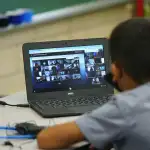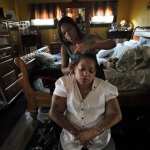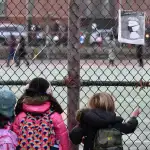The fire spread in 18 minutes.
Inside the Triangle Shirtwaist Factory, hundreds of mostly young, immigrant women rushed from door to door, only to find they had been locked by their bosses, part of a protocol to keep the women inside and working. Dozens jumped from the ninth floor of the burning building onto the streets of New York, dying on impact. In all, 146 workers perished.
Eighteen minutes of horror — and the course of a brewing labor movement was forever changed.
It was March 25, 1911. Female garment workers — including the workers at the Triangle factory — had already been banding together across the country to shout from soap boxes on street corners and strike by the thousands, fighting for basic workplace protections in the largest demonstrations seen at the time. They were protections that the Triangle Waist Company had refused to enact, including unlocking the exit doors so workers could take breaks, before dozens of their own burned.
The labor movement had already resonated with the White affluent women who were leading the broader push for suffrage, but the outrage over the fire was a catalyst, bringing into sharp focus that the fight for representation in both the workplace and in government were inextricably linked.
Clara Lemlich, a leader in both the labor and suffrage movements, put the argument this way in a 1912 piece published in Good Housekeeping: “The manufacturer has a vote; the bosses have votes; the foremen have votes; the inspectors have votes. The working girl has no vote. When she asks to have the building in which she must work made clean and safe, the officials do not have to listen.”

A century ago, working women joined with women across the socioeconomic spectrum to help pass the 19th Amendment in 1920 — work that was uneven and unequal then. Today, working low-, middle- and upper-class women are feeling the economic impact of the coronavirus pandemic, and it is galvanizing them to fight for better labor protections, all against the backdrop of an election year where voting rights are again at the forefront.
“Workers are understanding that we don’t have very much of a safety net or social insurance, and that there aren’t very many protections,” said Rebecca Dixon, executive director of the National Employment Law Project. “We’re at an inflection point where workers are wanting to join together to balance this power.”
The work that started a century ago remains unfinished, a fact that is bearing out in the data.
Women have experienced about 54 percent of all job losses since February. They have been laid off at record rates after the coronavirus set off the nation’s first female recession. Those returning to work in some of the industries women dominate — hospitality, education, retail — are wading through a patchwork of regulations that ensures many women don’t have access to paid sick leave. One in three women are essential workers, at times forcing them to decide between their health and economic livelihood.
And as for the mothers who were sent to work from home, the deterioration of the child care industry over the past several months and the uncertainty around school reopenings has left many women — who perform the majority of the child care in heterosexual working couples — in a position of choosing whether to care for their children or cultivate their career.
“People have been arguing that access to child care, paid leave, paid sick time and quality schooling have long been feminist issues,” said Alix Gould-Werth, director of family economic security policy at the Washington Center for Equitable Growth. “People are sort of starting to realize the degree to which they are also economic issues and engaging and centering that in the economic policy debate.”
Issues of child care and worker protections are likely to be key as the country formulates a coronavirus recovery for American pocketbooks.
The issue of resusicating the child care industry is expected to be a centerpiece of former Vice President Joe Biden’s presidential campaign. Child care will also likely be addressed in the next wave of relief — if Republicans and Democrats can agree on a package.
As for paid sick leave, the first coronavirus recovery act tried to address the gap by offering two weeks of paid sick time for the rest of the year to workers at small- and medium-sized companies. But the act included a wide exemption for companies with more than 500 employees and businesses with fewer than 50 employees. Only 20 percent of U.S. workers were ultimately covered.
Paid sick leave has not made it into the subsequent proposals for coronavirus relief proposed by the House or the Senate, an issue for the nearly 25 percent of all civilian workers who don’t have access to this benefit. That figure increases the less workers earn.
The U.S. is one of the only developed nations without a universal paid sick leave policy, which is part of the reason the issue has gained attention in the midst of a public health crisis that urged people to stay home if they were feeling sick.
The lack of a universal policy has already created problems for businesses, said economist Kate Bahn, director of labor market policy at the Washington Center for Equitable Growth.
“It is really difficult for the businesses who maybe want to offer better programs for their workers and particularly care about things like retaining their good workers, to do so if it’s not a universal program,” Bahn said.
Congress has shifted its focus to how companies can better protect themselves from lawsuits related to coronavirus. Many businesses are worried that customers or workers, who may not always abide by new COVID-19 safety rules, will try to sue operators if they get sick.
At the federal level, the agency that can protect workers, the Occupational Safety and Health Administration (OSHA), has received 9,190 complaints as of August 17 related to coronavirus, the agency told The 19th. It has issued just four citations.
Labor groups have criticized OSHA for failing to set an emergency temporary standard, a national set of required safety regulations that workplaces across America would have to abide by if they want to avoid facing citations and other fees. Instead, OSHA has laid out a set of guidelines for businesses to follow, but that lack an enforcement component.
“It’s sort of an employer-by-employer honor system. There’s no way to hold them accountable,” Dixon said.
OSHA has defended the decision to not adopt emergency rules, saying its standards, in addition to its coronavirus guidelines, are sufficient. Labor Secretary Eugene Scalia wrote in a late April letter to AFL-CIO union president Richard Trumka that the agency would not adopt an emergency standard because “OSHA’s industry-specific guidance is far more informative for workers and companies about the steps to be taken in their particular workplaces.”
“That is one of the reasons OSHA has considered tailored guidance to be more valuable,” Scalia wrote.
The AFL-CIO ultimately responded by suing OSHA in May, but the case was rejected a month later after a federal appeals court ruled that the agency “reasonably determined that an [emergency temporary standard] is not necessary at this time.”
Another lawsuit, filed by workers at a meatpacking facility outside Scranton, Pennsylvania against the agency, is still pending.
OSHA’s advent, coincidentally, dates back to Triangle Shirtwaist Factory fire: Frances Perkins, who witnessed the flames engulf the building, was so moved by what she saw that she went on to become secretary of labor and establish OSHA’s precursor, the Labor Standards Bureau.
Labor activists also say liability protection for businesses could shield some that may not be acting to protect their employees. Dawn Huckelbridge, director for Paid Leave for All, said the focus on immunity is almost an admission that workers are likely to get sick on the job.
That’s particularly worrisome for women who are most likely to be in fields that don’t offer the benefit. Of the 40 lowest-paying jobs, women make up nearly two thirds of the workforce, which includes industries like hospitality, where only 33 percent of workers have access to paid leave, and retail, where 61 percent of workers have it.
Earlier this year, McDonald’s workers and employees at Instacart, the app that hires personal shoppers to get your groceries for you, went on strike to protest working conditions related to coronavirus.
The tension is not unlike the one working women were experiencing in the early 20th century when they were fighting for workplace safety and recognition.
In the early 1900s, low-wage garment workers “were pioneering public protests, long before the suffragists decided they were willing to adopt tactics,” said Allison Lange, author of “Picturing Political Power: Images in the Women’s Suffrage Movement.”

As working women started to join the fight for the vote in larger numbers, they brought their tactics along with them, helping to energize the suffrage movement in the hopes that women could push for regulations at the federal level, not just in their individual places of work.
But when the 19th Amendment finally passed, it, like the movements that helped put it in place, did not equally advocate for all women. Women of color did not truly obtain access to the ballot until the Voting Rights Act of 1965, and even still, women of color and marginalized groups continue to struggle with disenfranchisement.
“Wealthier White women were the visible leaders, and they were also actively sidelining Black women suffragists who wanted the right to vote and specifically because of the racial terror and lynchings in the South,” Dixon said. “Voting rights are still tied to building power to address racial terror and systemic racism, like what we’re seeing driving the uprising that we’re seeing right now. Voting rights are as important today as they were then.”
That history has followed women of color in the decades since, putting them in a more precarious position when the pandemic hit this year that made them more likely to get sick and lose their jobs.
Latinas have suffered the highest rate of unemployment of all groups as a result of coronavirus-induced job losses. Unemployment for them peaked at 20.2 percent, followed by Black women, for whom the jobless rate peaked at 16.5 percent. That figure topped out at 13.1 percent for White women.
Still, the rates are record highs for each of the racial and ethnic groups, creating a shared experience of suffering — though to wildly varying degrees — that has turned many women onto the urgency of this moment, much like women of all backgrounds felt the momentum to secure the vote a century earlier.
Workers are also eyeing the election in November in much the same way women looked to the 19th Amendment one hundred years ago: As an opportunity to play a role in the process.
“Fundamentally, people have felt powerless through this virus because of the virus itself, but because of the way that both the government and the employers have treated people put either out of work without adequate wages and benefits or at work in unsafe conditions,” said Gwen Mills, the secretary-treasurer of Unite Here, the union that merged with the International Ladies’ Garment Workers’ Union, the group that fought for protections following the Triangle Shirtwaist Factory fire.
Mills said the union has been trying to make the connection this year between the role unions play in the workplace and the one they can play to help workers become more involved in the electoral process, guiding them through the steps of sending a mail-in ballot or getting registered, particularly in immigrant communities where there are more barriers to getting workers to the polls.
About 85 percent of Unite Here’s members across the nation — largely hotel, food service and airport workers — are out of work. That’s changed the lens through which they’re looking at the 2020 election, Mills said.
“We often talk with our members about opportunities to volunteer for the election. It’s always people balancing multiple priorities. But this year, it’s just much more straightforward to talk with people and they’re much more willing to commit the time to do it,” Mills said. “To me that has echoes of 100 years ago, when workers were figuring out how to organize in the shop and figure out how to expand the right to vote for women.”





